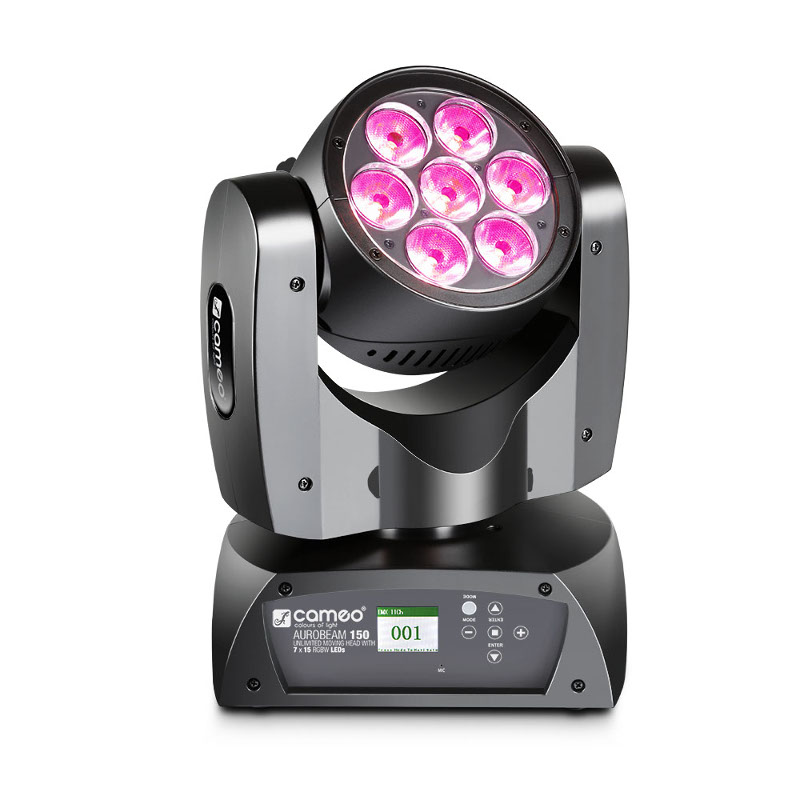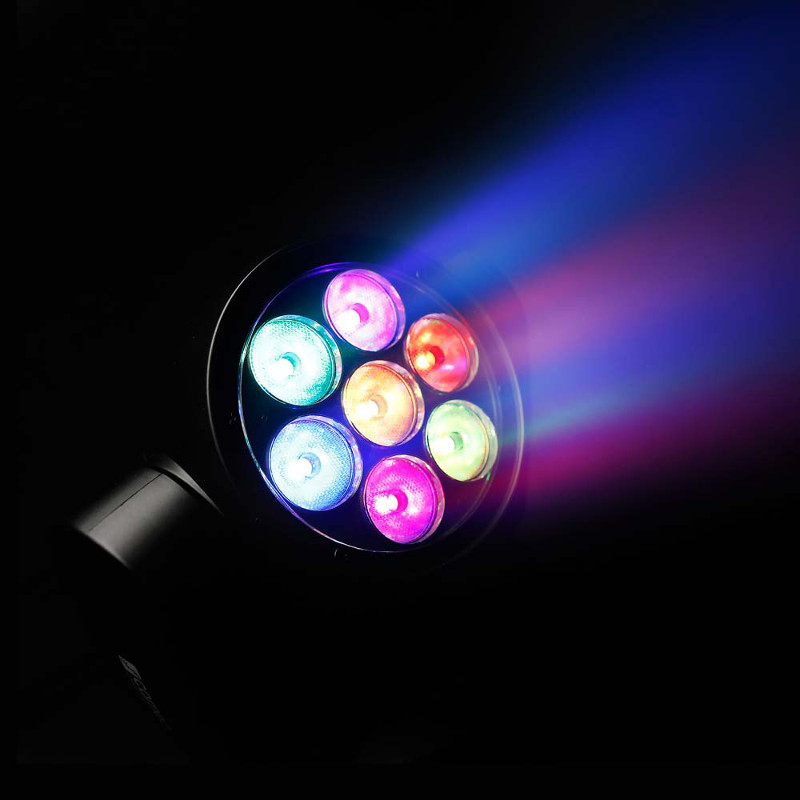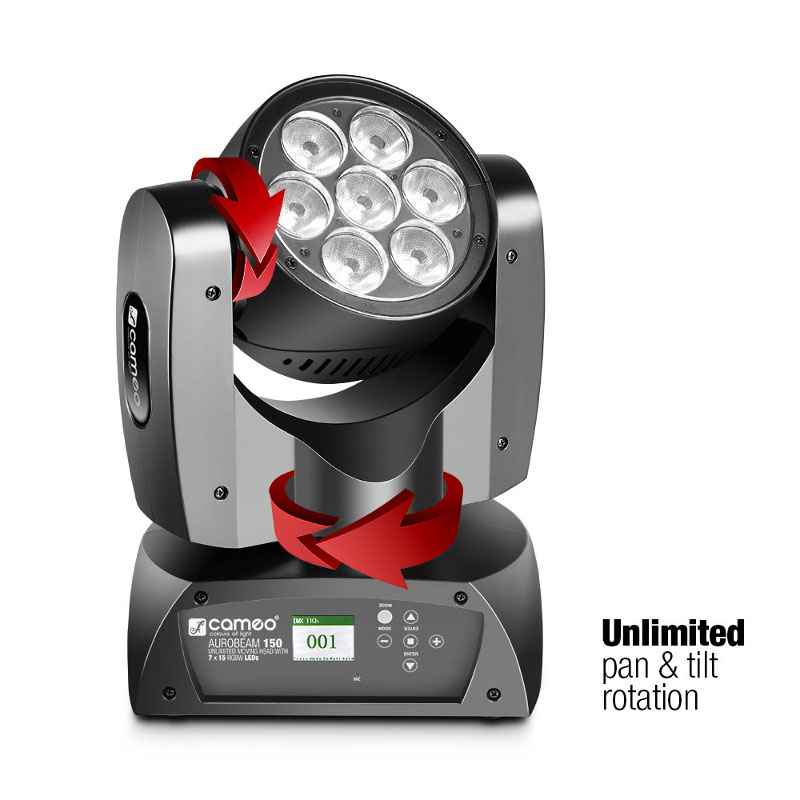Cameo Aurobeam 150 – LED Beam on motorised moving head – test report by soundlightup
As open-minded people, we have decided to overcome our prejudices and to test a spotlight from the land of the rising sun, which is presented by Adam Hall under its brand Cameo as a product specifically designed according to company specifications. This small motorised LED light has a compact and well-contoured design and features some interesting characteristics such as continuous rotation or 7 individually controllable sources. We have subjected it to an endurance test.

First of all
Our first impression of the Aurobeam 150 is quite positive. This small moving head has an appealing design, full of curves and seems to be very well-finished. 4 XLR connections with 3 and 5 pins for the DMX and RDM signal, as well as two PowerCON Neutrik connectors are located on the base, one of which being for the return.
The menu with an LCD display and 5 navigation buttons is located on the other side. A small detail proves the high-quality processing of the moving head: When it receives a signal in DMX mode, the display turns green, otherwise it remains red – this way, the status of the spotlight is always simply and clearly displayed and any wiring problems can be easily localised and dealt with. The menu also features all of the common displays.
The device is controlled via 4 DMX modes with 5 to 41 channels each or auto modes as master / slave, sound-to-light, etc. In DMX mode, the range extends from the basic settings for controlling the internal presets to individual control of each single LED with additional internal effects: there is something for every user. In auto mode, every parameter for each light source can be defined in the menu for a particular setting. Dynamic tunings are possible through the use of internal programs or a programmable scene sequence. The setting parameters allow, among other things, for the selection of one of the 3 speeds of the fan or the calibration of the pan and tilt motors.
At first glance, it seems that the device is quite promising. Let’s take a look at what it can achieve.

The Fundamentals
The first test is of course the derating. Firstly, it allows for the stabilisation of the light beam to enable photometric measurements and then, it provides instant information on the cooling capacity and the control of the LEDs.
After selecting the “normal” cooling mode in the menu, we run the spotlight at full power in RGBW and measure the illuminance in the centre of the light beam projected onto the target every 5 minutes, until we get a stable reading. These values enable us to create a derating curve for representation of the lighting intensity in relation to the warm-up time.
Immediately after switching on, with cold LEDs, we measure 2525 lux; after 30 minutes warm-up time, the lighting stabilises to 2350 lux, representing 93% of the output value. The derating is therefore a maximum of 7%, a very good value. In RGB at full power, we measure the same value of 7%. If only 2 colours out of a total of 7 sources are switched on (red and green), this value even drops to 1.2%. The light can therefore be considered as quite stable.
We take a lunch break and leave the spotlight turned on full power in RGBW. When we come back after over an hour, the Aurobeam still lights up as one and we can start with the photometric measurements.
We measure a beam angle of 8.4°at I/2 (intensity in the centre /2) and 16.11 °at I/10. The luminous flux is 1870 lumen after derating and 2010 lumen in cold state. These are very good values given the output. We draw the dimmer curve as shown below. There is only one, but this is perfectly adequate for a beam spotlight. We notice that the curve has a slight S-shape that is located between a halogen curve and a linear.
In practice
Despite loving the impressive figures: there is nothing better than a practical test. We found that the light beam, in spite of a very strong halo effect, is clearly defined. The light mixture is homogeneous. Clearly, with an opening of 16° there is not much that can go wrong, but it still happens with some.
The only point of criticism on the colour spectrum is that the yellow light resulting from the mixture of red and green chips is quite toxic, very green-heavy. For users who prefer to create their own colour palettes or macros, they will have to account for this in order to deal with other devices.
One of the advantages of LEDs is of course their speed in changing colours without any delay. Here, we noticed no abnormality in the colour change, neither for long nor for short times. As usual, there is a possibility to preset the trichromy, namely channel 38 in the 41 channels mode.
Personally, I am not an enthusiastic user of this parameter, but the CTO – and CTB presets are quite useful, and the 233-255 DMX values have a ‘sound mode’ feature (colour change), with which to vary the colours according to the rhythm of the music via the internal microphone. This option, via a DMX-parameter, is especially interesting for dance events.

The “Lighting Auto Programs” function on channel 39 should also be attractive to organisers of such events because of the great ambiance it is sure to create. It includes 12 preprogrammed internal animation programs as well as 2 colour effects and a music mode, which uses the microphone with the internal patterns.
The pan and tilt movements are hard to beat in terms of speed. Even if they are not high-voltage hybrids, the motors move the head easily and precisely, at very high or even low speeds, if necessary. Channel 7 (Motor Running Speed (fast to slow)) is also very useful for changing the speed to achieve the best possible results. This moving head also allows for continuous rotation on the pan and tilt axes. It works perfectly on all axes and at all speeds. As always, it is relatively loud, which is particularly noticeable at high speed but this is not really a nuisance given that fast effects are rarely needed in quiet surroundings.
As regards to the movement functions, be it in the 19 or 41 channels mode: Since the Pan Fine and Tilt Fine parameters do not follow the Pan and Tilt channels (Pan, Pan Fine, Tilt, Tilt Fine), it is essential to use a console to be able to freely allocate DMX channels. A small drawback for this otherwise great spotlight.
The last note-worthy setting option is the function for individual control of the LEDs, which is rarely found in other devices in this price class. Therefore, depending on your preference, all light sources can be used together or certain images and effects can be obtained using all light sources. Obviously, for an optimal result, a large number of spotlights would be needed. The only unknown is the binning of the LEDs chosen by the manufacturer, meaning the sorting by colour, luminous flux and forward voltage. If the tolerances are too high, this leads to a gap between the devices, that would be noticed within a set of spotlights and could spoil the intended effects.
The inner workings
We now take a look inside the spotlight. A single phillips-head screwdriver is sufficient to take the device apart. After removing the cover, a transparent plate can be seen whose function is not obvious.
It could be a flare protection, which in this case would not be very effective. Perhaps it is just ornamental? If you remove this plate, you will access a metal plate used to keep the 7 collimators in position, which have a 40 mm diameter. It also allows for the overlay of the axis of each lens with each of the corresponding LEDs for a best possible light mix and a uniform beam of light.
After removing this metal plate, you can see the flange which is at the centre of the collimators. These have two pins at the bottom, which keep them in place on the LED circuit. They are easily accessible and can be serviced without a problem, benefiting the quality of light.
If you turn the moving head upside down, you can discover the cooling system under the rear panel: in comparison to the size of the head, it is quite an imposing cooler and fan. Thanks to these two elements in a circuit with a relatively low LED density, Cameo keeps a good grip on the derating. Now to the moving head. As expected, the tilt mechanism is located on one side, with a small perforated wheel underneath that enables indexing and thus the repositioning of the axis, and a large gear to drive the head which is located above. On the other side, we find the control card for the motors and the manifold which allows for continuous rotation of the head by connecting the base with the LED card through a series of contacts.
The whole device can be easily reassembled. The joints are clean and the holes for the screws are exactly aligned with the thread. This is often more important than you might think.

The final word!
This little device is quite a nice surprise. It looks good, is easy to use and at the same time very powerful. Cameo dispenses with a complex zoom and instead provides a continuous pan / tilt rotation and an individual control of the LEDs, which makes the Aurobeam 150 a genuine all-rounder. This spotlight is not the most technically advanced nor the most powerful, since this is not the point of this device; instead it offers excellent value for money.
Because of its low power output, it is not intended for medium and large stages; however it is ideally suited to use in small concert halls, in clubs and for mobile applications to enliven the chosen event location. Due to its small size and weight, it is hardly noticeable, can be easily integrated in many locations and is also easy to transport. This spotlight is also well thought out.
The numerous DMX setting options allow you to achieve effective and original effects. Even people without previous knowledge in lighting can easily operate this spotlight in auto mode. The excellent quality of this device has already convinced 3 French companies (Melpomen, l’Atelier de l’Evénement and Stocklight) to include this spotlight in their equipment. Cameo impresses not so much by innovation, but rather by quality. We will keep a close eye on any new developments.
What we like
+ the Processing
+ the Design
+ the easy operation
What could be better
– The rather strong halo effect
– the yellow light with a greenish tinge
_________________________________
Source: soundlightup.de; August 2016: http://www.soundlightup.com/archives/essais/cameo-aurobeam-150.html
Author: Stephane Mocret
For more information:
http://www.cameolight.com/en/products/led-moving-heads/auro-beam-150-7-x-15-w-rgbw-led-unlimited-moving-head/
Leave a Comment
You must be logged in to post a comment.












